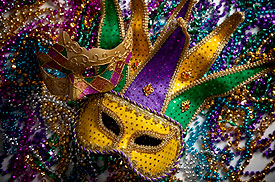The Story of Mardi Gras
Mardi Gras came to New Orleans through its French heritage in 1699. Early explorers celebrated this  French Holiday on the banks of the Mississippi River. Throughout the years, Orleanians have added to the celebration by establishing krewes(organizations) which host parades and balls. Carnival quickly became an exciting holiday for both children and adults.
French Holiday on the banks of the Mississippi River. Throughout the years, Orleanians have added to the celebration by establishing krewes(organizations) which host parades and balls. Carnival quickly became an exciting holiday for both children and adults.
Mardi Gras means “Fat Tuesday” and of course is celebrated on that day of the week. The date can fall between February 3 and March 9 depending on the Lunar calendar, used by the Catholic Church to determine the date of Easter. Mardi Gras is always 47 days before Easter Sunday.
The official colors for Mardi Gras are purple, green, and gold. These colors were chosen in 1872 by the King of Carnival, Rex. He chose these colors to stand for the following:
- Purple represents justice
- green stands for faith
- gold stands for power
The Mardi Gras season begins on January 6 and continues until Fat Tuesday, the day before Ash Wednesday. On the Christian calendar, the twelfth day after Christmas is known as “Epiphany”, “Twelfth Night”, or “Kings Day.” It is the day the gift-bearing Magi visited the baby Jesus, and is celebrated with its own unique rituals.
Click for an expanded view of the History of Mardi Gras



